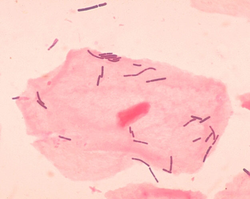| Genus | Meaning of the genus name | Properties of the genus |
|---|
| Lactobacillus | Rod-shaped bacillus from milk | Type species: L. delbrueckii . Homofermentative with strain-specific ability to ferment pentoses, thermophilic, vancomycin-sensitive, adapted to vertebrate or insect hosts. |
| Holzapfelia | Wilhelm Holzapfel's lactobacilli | Type species: H. floricola . Homofermentative, vancomycin sensitive, unknown ecology but likely host-adapted. |
| Amylolactobacillus | Starch-degrading lactobacilli | Type species: A. amylophilus . Homofermentative, vancomycin sensitive, extracellular amylases are frequent, unknown ecology but likely host-adapted. |
| Bombilactobacillus | Lactobacilli from bees and bumblebees | Type species: B. mellifer . Homofermentative, thermophilic, vancomycin resistant, small genome size, adapted to bees and bumblebees |
| Companilactobacillus | Companion-lactobacillus, referring to them growing in association with other lactobacilli in cereal, meat and vegetable fermentations | Type species: C. alimentarius . Homofermentative with strain- or species-specific ability to ferment pentoses, vancomycin resistant, unknown ecology, likely nomadic |
| Lapidilactobacillus | Lactobacilli from stones | Type species: L. concavus . Homofermentative with strain- or species-specific ability to ferment pentoses, vancomycin resistant, unknown ecology. |
| Agrilactobacillus | Lactobacilli from fields | Type species: A. composti . Homofermentative, aerotolerant and vancomycin resistant. Genome size, G+C content of the genome and the source of the two species suggest a free-living lifestyle of the genus. |
| Schleiferilactobacillus | Karl Heinz Schleifer's lactobacilli | Type species: S. perolens . Homofermentative, vancomycin resistant, aerotolerant. Schleiferilactobacillus spp. have a large genome size, ferment a wide range of carbohydrates, and spoil beer and dairy products by copious production of diacetyl. |
| Loigolactobacillus | (Food) spoiling lactobacilli | Type species: L. coryniformis . Homofermentative, vancomycin resistant, mesophilic or psychrotrophic organisms. |
| Lacticaseibacillus | Lactobacilli related to cheese | Type species: L. casei . Homofermentative, vancomycin resistant; many species ferment pentoses, and are resistant to oxidative stress. L. casei and related species have a nomadic lifestyle. |
| Latilactobacillus | Widespread lactobacilli | Type species: L. sakei . Homofermentative, mesophilic free living and environmental lactobacilli. Many strains are psychrotrophic and grow below 8 °C. |
| Dellaglioa | Franco Dellaglio's lactobacilli | Type species: D. algida . Homofermentative, vancomycin resistant, aerotolerant and psychrophilic. |
| Liquorilactobacillus | Lactobacilli from liquor or liquids | Type species: L. mali . Homofermentative, vancomycin resistant, motile organisms growing in liquid, plant-associated habitats. Many liquorilactobacilli produce EPS from sucrose and degrade fructans with extracellular fructanases. |
| Ligilactobacillus | Uniting (host adapted) lactobacilli | Type species: L. salivarius . Homofermentative, vancomycin resistant, most ligilactobacilli are host adapted and many strains are motile. Several strains of Ligilactobacillus express urease to withstand gastric acidity. |
| Lactiplantibacillus | Lactobacilli related to plants | Type species: L. plantarum . Homofermentative, vancomycin resistant organisms with a nomadic lifestyle that ferment a wide range of carbohydrates; most species metabolise phenolic acids by esterase, decarboxylase and reductase activities. L. plantarum expresses pseudocatalase and nitrate reductase activities. |
| Furfurilactobacillus | Lactobacilli from bran | Type species: F. rossiae . Heterofermentative, vancomycin resistant, with large genome size, broad metabolic potential and unknown ecology. |
| Paucilactobacillus | Lactobacilli fermenting few carbohydrates | Type species: P. vaccinostercus . Heterofermentative, vancomycin resistant, mesophilic or psychrotrophic, aerotolerant, most strains ferment pentoses but not disaccharides. |
| Limosilactobacillus | Slimy (biofilm-forming) lactobacilli | Type species: L. fermentum . Heterofermentative, thermophilic, vancomycin resistant with two exceptions, Limosilactobacillus species are vertebrate host adapted and generally form exopolysaccharides from sucrose to support biofilm formation in the upper intestine of animals. |
| Fructilactobacillus | Fructose-loving lactobacilli | Type species: F. fructivorans . Heterofermentative, vancomycin resistant, mesophilic, aerotolerant, small genome size. Fructilactobacilli are adapted to narrow ecological niches that relate to insects, flowers, or both. |
| Acetilactobacillus | Lactobacilli from vinegar | Type species: A. jinshani . Heterofermentative, vancomycin resistant, grow in the pH range of 3–5; fermenting disaccharides and sugar alcohols but few hexoses and no pentoses. |
| Apilactobacillus | Lactobacilli from bees | Type species: A. kunkeei . Heterofermentative, vancomycin resistant, small genome size, fermenting only few carbohydrates, adapted to bees and/or flowers. |
| Levilactobacillus | (Dough)-leavening lactobacilli | Type species: L. brevis . Heterofermentative, vancomycin resistant, mesophilic or psychrotrophic, metabolise agmatine, environmental or plant-associated lifestyle. |
| Secundilactobacillus | Second lactobacilli, growing after other organisms depleted hexoses | Type species: S. collinoides . Heterofermentative, vancomycin resistant, mesophilic or psychrotrophic, environmental or plant-associated lifestyle. Adapted to hexose-depleted habitats, most strains do not reduce fructose to mannitol but metabolize agmatine and diols. |
| Lentilactobacillus | Slow (growing) lactobacilli | Type species: L. buchneri . Heterofermentative, vancomycin resistant, mesophilic, fermenting a broad spectrum of carbohydrates. Most lentilactobacilli are environmental or plant-associated, metabolise agmatine and convert lactate and/or diols. L. senioris and L. kribbianus form an outgroup to the genus; both species were isolated from vertrebrates and may transition to a host-adapted lifestyle. |



